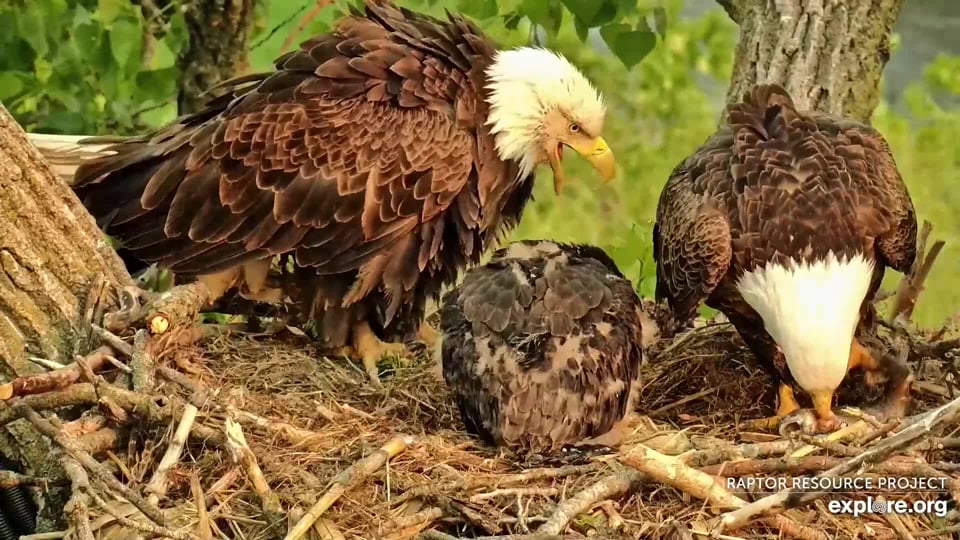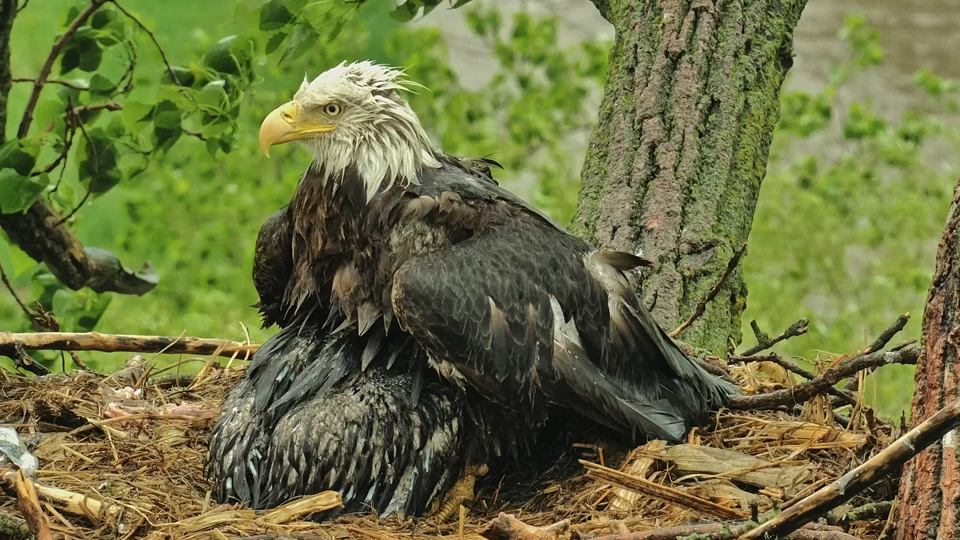Some of you have expressed concern that our eagle parents aren’t properly caring for or feeding their young. We’re still seeing plenty of parental care – DH2 got three feedings just this morning! – but we’re also seeing a lot less brooding and a lot more alone time. While at least one eagle parent is always in the area, they aren’t always on the nest. What’s going on? Older eaglets no longer require (or want) continuous brooding, and their parents are going through hormonal changes. Our eagle families are growing up!

May 17, 2023: Recent eagle behavior has some fans worrying about eagle divorce!
Hormonal changes
Daylight length, or photoperiod, strongly influences hormone production in birds. In northern north America, our bald eagle story begins shortly after the winter solstice in December. As daylight length increases, a cascade of hormones causes birds’ gonads to swell, increasing the production of testosterone in males and progesterone (plus a small amount of testosterone) in females. Testosterone is associated with aggression, territoriality, courtship, nest-building and, in males, testicular development and spermatogenesis, while progesterone, the “pregnancy hormone”, induces egg production in females.
Eagle parents share incubation and brooding, so both of them experience another hormonal change once incubation begins. Production of prolactin, a hormone that induces incubation and stimulates brood patch development, rises sharply, while testosterone and progesterone production rapidly decrease. Opioid peptides help stimulate prolactin production, which may be another reason that normally active birds suddenly want to spend the entire day sitting on eggs.
So in the first part of their reproductive cycle, Mom and Dad’s interactions with one another and their young are mediated by hormones that stimulate courtship, mating, territoriality, egg-laying, and lethargy. We humans are moved by their relationship with one another and their tender devotion to their offspring. It’s hard not to see hearts everywhere – I know I did! – as eagles court, males give food gifts to females, and both eagles work together to keep eggs and young safe from all the extremes Iowa’s winter and early spring can bring.

May 14, 2023: DH2 is a little too large for brooding, but HM is doing her best!
And then they start shaking the prolactin off
If the eagles’ earlier behavior added up to love, it’s hard not to see this as its opposite. Hours of tender brooding care, delicate feedings, and eagle passion are replaced as tiny bobbleheads grow too big to brood and big enough to feed themselves while parents seem standoffish and aloof, watching their young from distant branches. In this narrative, our eagle family is drifting apart. While compelling to human watchers, this scenario isn’t true.
So what is happening to our eagles? As eagle gonads begin shrinking, they decrease courtship and pair bonding behaviors. As prolactin ebbs, their metabolisms speed up, they become more physically active, their body fat drops slightly, and they probably become hungrier. How about their young? Five-week-old eaglets have thermal down and are growing juvenile feathers. They don’t need (or want) brooding, they can feed themselves, and they are always hungry! Strong, snapping beaks and increased mobility can pose a threat to parental toes, while constant food-begging would put a crimp in anyone’s day.
What we interpret as a falling out is simply normal eagle behavior. Adults are resuming the non-reproductive phase of their lives, while eaglets are getting ready to fledge. At least one adult is always nearby and will step in as needed, but eaglets no longer need constant care. To paraphrase Scott Weidensaul, sex hormones pull many strings in a bird’s body. We are seeing that at our nests right now.
Things that helped me write this post
 The Raptor Resource Project
The Raptor Resource Project The Raptor Resource Project
The Raptor Resource Project